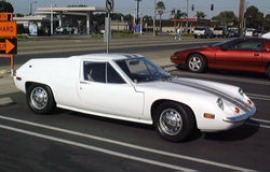Lotus Europa

The Lotus Europa or Lotus Europe was a two door mid-engined GT coupé built by Lotus Cars from 1966 to 1975. In 2006 Lotus began production of a totally new, Lotus Elise-derived design, a mid-engined GT coupé named Europa S.
The original Europa used Lotus founder Colin Chapman's minimalist steel backbone chassis that was first used in the Lotus Elan, while also relying on its fibreglass moulded body for structural strength. The Europa was the first mass-produced mid-engine road car and was based on a prototype built to compete for Henry Ford II's contract to build a Le Mans race car in the early 1960s.
The Europa was designed and built to be an embodiment of Chapman's oft-stated philosophy of automotive design: "Simplify, then add lightness."
The 4-wheel independent suspension was typical of Chapman's thinking; the rear suspension consisted of two relatively large trailing arms, one lower locating link per side, and the axles were used as upper locating links; very similar to Formula racing car designs of that era. Aside from the doors, bonnet (hood), and trunk (boot), the body was cast as a single unit of fibreglass.
The car's handling prompted automotive writers to describe the Europa as the nearest thing to a Formula car for the road.
In all, Lotus built about 9,300 Europas.
The concept originated during 1963 with drawings by Ron Hickman, director of Lotus Engineering (Designer of the original Lotus Elan, as well as inventor of the Black and Decker Workmate), for a bid on the Ford GT40 project. That contract went to Lola as Colin Chapman wanted to call the car a Lotus and Henry Ford II insisted it would be called Ford. Chapman chose to use Hickman's aerodynamic design (with a still respectable today drag coefficient of Cd 0.29) as the basis for the Europa production model; originally intended to succeed the ageless Lotus 7.
Information from http://en.wikipedia.org/wiki/Lotus_Europa
Related pages: Cars, Lotus Elise
